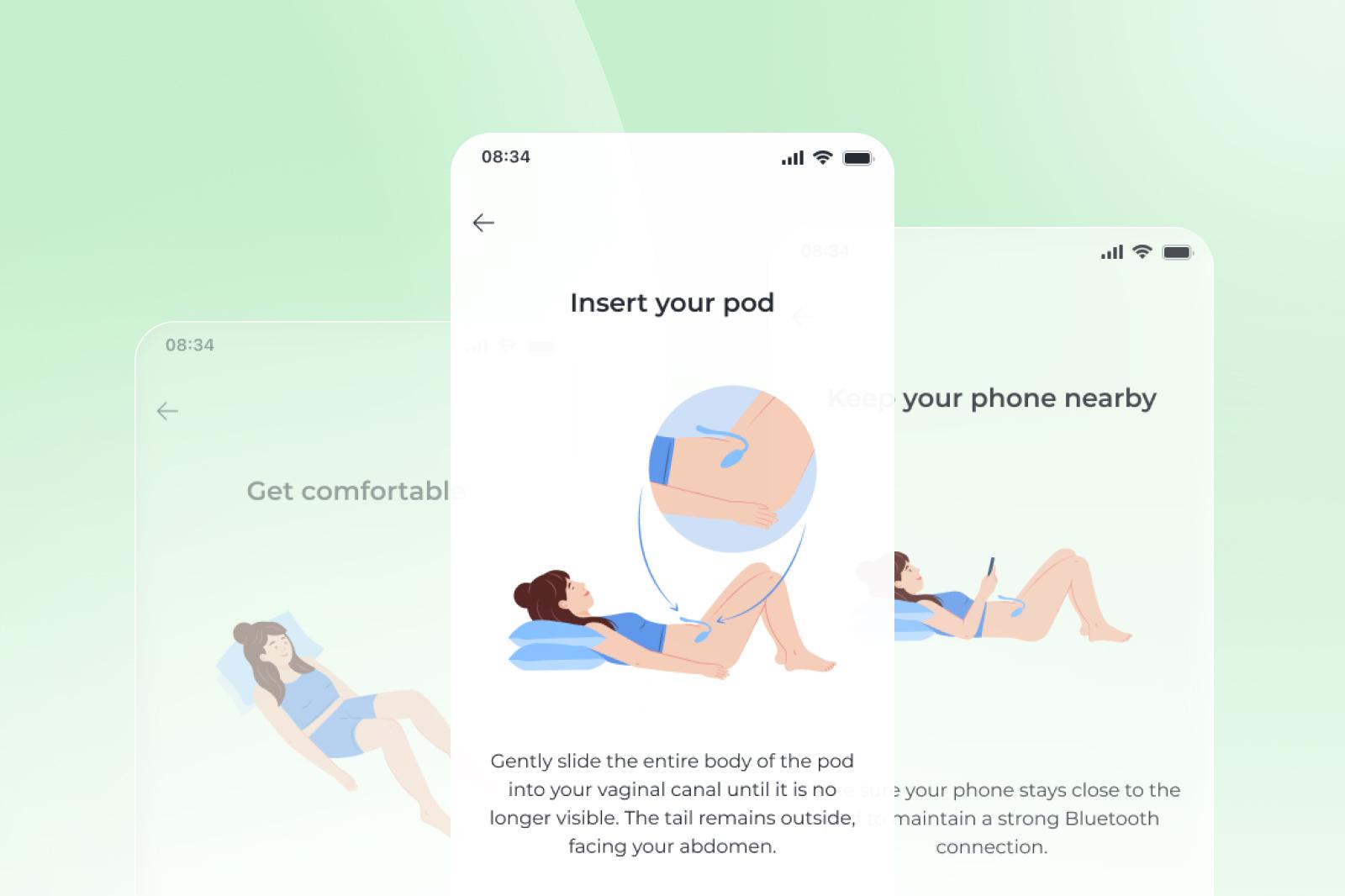November 28, 2025 • min read
Menopause and pelvic pain relief: Don’t suffer in silence
Pelvic pain and dysfunction are common during menopause, but relief is possible. Learn what causes these symptoms and how Bloom helps women regain strength and comfort.
Written by

Senior Clinical Program Manager, Sword Bloom ·
The Sword Summary Warm-up
Don’t have time for the full workout? We’ve got you covered with a quick, high-intensity session. Here are the key takeaways:
- Pelvic pain and dysfunction are common during menopause, yet many women struggle in silence or assume these symptoms are simply part of getting older.
- Hormonal changes can affect muscle tone, elasticity, and coordination in the pelvic floor, leading to tightness, pressure, or loss of control.
- This guide explains what’s happening in your body, the difference between pain and dysfunction, and how Bloom provides accessible, evidence-based digital pelvic care to help women regain comfort and confidence safely, privately, and from home.
What causes pelvic pain during menopause?

If you have noticed new tension, pressure, or aching in your pelvis during menopause, you are far from alone. Research shows that up to one in three women experience some form of pelvic discomfort during this time¹. Many describe it as a dull ache, a sense of heaviness, or even sharp spasms that come and go without warning.
- During menopause, declining estrogen levels change the way tissues and muscles behave.
- Estrogen helps keep the pelvic area hydrated, elastic, and well supported².
- When levels drop, the pelvic floor muscles and connective tissues can lose flexibility, making them feel tighter and more reactive.
At the same time, muscles that once provided reliable stability may start to weaken from disuse, hormonal changes, or posture shifts. This imbalance between tension and weakness can create new feelings of strain or discomfort.
Some women also notice related issues such as:
- Bladder urgency or changes in urinary control
- Lower back or hip discomfort
- Pain during movement or intimacy
- A feeling of heaviness or pelvic pressure
These symptoms are your body’s way of asking for care. They do not mean something is wrong, only that your muscles are adjusting to new hormonal rhythms. With guidance and regular care, you can support them back into balance.
Is pelvic pain the same as pelvic floor dysfunction?
Many women are surprised to learn that pelvic pain and pelvic floor dysfunction are related but not the same. Understanding the difference helps you identify what your body needs and how to address it effectively.
Pelvic pain happens when muscles become overactive or tight. These muscles hold tension even when they are not needed, which can lead to discomfort, pressure, or cramping. This type of pain can appear after long periods of sitting, with certain movements, or during intimacy. The goal of care for this kind of pain is learning how to relax and release tension.
Pelvic floor dysfunction (PFD) occurs when the pelvic muscles are weak, uncoordinated, or unable to contract and release properly³. Common symptoms include:
- Urinary leakage
- Constipation or difficulty emptying the bladder
- A sensation of pelvic heaviness
- Lower back or hip discomfort
It is common to experience both tightness and weakness at the same time. That’s why the expert-guided pelvic care from Sword's Bloom program is so effective. A Women’s Health Specialist can assess your needs and guide you through personalized exercises that help your body regain both strength and relaxation.
Why is pelvic dysfunction more common in menopause?
Menopause is a natural stage of life, but hormonal changes can influence how the pelvic floor functions. Lower estrogen levels can cause:
- Reduced tissue hydration and elasticity: The pelvic muscles and connective tissues may become less flexible and more sensitive to pressure.
- Loss of muscle tone; Muscles in the core and hips weaken, increasing strain on the pelvic area.
- Changes in posture and coordination: These affect how pressure is distributed when you sit, stand, or lift.
- Reduced physical activity: Less movement can lead to stiffness and discomfort.
While these shifts are normal, they do not have to lead to discomfort. The pelvic floor remains adaptable throughout life. With proper movement, attention, and care, it is possible to restore balance and comfort at any age.
Bloom gives you personalized pelvic care from home

Many women delay seeking help for pelvic pain or leakage because of embarrassment, uncertainty, or misconceptions about what pelvic care involves. Some imagine that treatment requires invasive exams or uncomfortable procedures.
Today’s pelvic care is very different. It is gentle, educational, and completely centered on comfort and privacy.
Bloom offers a safe and discreet way to access professional guidance from home. Every member begins with a digital assessment and works one-on-one with a Women’s Health Specialist who holds a Doctor of Physical Therapy degree.
Get started with Sword Bloom in 4 easy steps

1. Tell us about you
Share your symptoms, health history, and goals so we can personalize your care.

2. Meet your clinician
You’ll be matched with a Pelvic Health Specialist who will guide your recovery and adjust your plan as you go.
3. Receive your Bloom kit
We’ll ship everything you need, including the Bloom Pod, directly to your door.
4. Begin your recovery at home
Get expert support and real-time feedback, all from the privacy of home.
Your specialist creates a personalized program tailored to your symptoms, goals, and mobility level. Sessions last just 10 to 15 minutes and focus on simple, guided movements that teach you how to strengthen and relax your pelvic muscles safely.
Members can use the optional Bloom Pod, an FDA-listed biofeedback device, to receive gentle real-time feedback during exercises.
- You can message your specialist through the Sword mobile app for ongoing support and progress tracking.
- The process is private, approachable, and designed to make you feel empowered.
- There are no clinical rooms, waiting lists, or awkward conversations.
- Bloom gives you 24/7 access to a personalized care plan prepared by a women’s health specialist so you can fit your exercises into your schedule

How to manage pelvic pain during menopause
Your pelvic health can improve with small, consistent habits. The following strategies can help you relieve tension and prevent recurrence:
To relieve pelvic pain when it occurs
- Move gently. Try light walking or stretching to increase circulation and ease stiffness.
- Breathe deeply. Slow, steady breathing calms the nervous system and helps release muscle tension.
- Adjust your posture. Avoid sitting for long periods without breaks.
To reduce recurrence of pelvic pain
- Practice guided pelvic exercises through Bloom. These help retrain your muscles to stay strong and relaxed.
- Stay hydrated. Drink water throughout the day to support tissue health.
- Eat nutrient-rich foods. Include omega-3s, antioxidants, and calcium to support recovery.
To prevent long-term discomfort
- Stay consistent. A few minutes of pelvic care each day can protect your comfort long-term.
- Combine movement and mindfulness. Gentle awareness of your body helps you notice and correct tension early.
- Use supportive care like Bloom for structure and motivation.
Your muscles are resilient and capable of change. With a little care and attention, they can regain their natural balance and strength.
When to seek additional care
If pelvic pain, heaviness, or leakage interferes with daily life, sleep, or intimacy, it is time to seek support. These are signs your pelvic floor needs more attention — not that you have done something wrong.
Even mild symptoms should be addressed early. Bloom’s Women’s Health Specialists monitor progress, adjust programs as needed, and guide members toward additional medical evaluation if necessary. This ongoing partnership means you never face these challenges alone.
Regain control and manage your pelvic health with Bloom
Pelvic pain and dysfunction are common during menopause, but they are not permanent. With understanding, support, and gentle care, your body can recover its balance and strength.
Many employers and health plans include Bloom as a covered benefit. Checking eligibility takes less than two minutes:
- Check to see if your health insurance plan has coverage for Bloom
- Enter your employer or insurance details
- If you are covered, you can begin your personalized program within days
You deserve to feel comfortable, confident, and supported in this stage of life. Bloom makes that care simple, safe, and accessible so women don’t have to deprioritize work or family commitments to schedule an appointment and commute to a medical clinic.
Join 500,000+ people using Sword to end their pain
Recover from pain from the comfort of your home with clinically-proven expert care
Footnotes
Sword Health. Menopause at Work Whitepaper. 2025. https://swordhealth.com/resources/whitepapers/menopause-at-work
Sword Health. Bloom ROI Whitepaper. 2025. https://swordhealth.com/resources/whitepapers/bloom-pelvic-health-roi
Thompson JA, et al. Journal of Women’s Health Physical Therapy. 2020;44(3):145–153. https://doi.org/10.1097/JWH.0000000000000153
Li X, et al. Frontiers in Endocrinology. 2022;13:823454. https://doi.org/10.3389/fendo.2022.823454